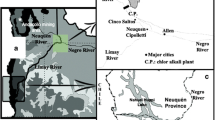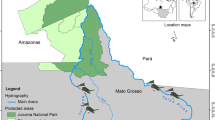Abstract
Mercury concentrations in feather, liver, kidney, and muscle tissue of Little egret (n = 8) and Cattle egret (n = 3) from Shadegan Wetlands in south-western Iran were examined. Liver of Little egret had significantly higher mercury compared to Cattle egret (p < 0.05). In addition, mercury values were consistently larger in Little egret when compared to Cattle egret, but mercury levels found in feather, kidney, and muscle did not differ statistically between the two bird species (p > 0.05). The small Cattle egret sample size, however, makes it difficult to conclude that the same trend would persist had we been able to include more Cattle egrets in this study. An interesting regional comparison between mercury concentrations in the feather of Little egret chicks, from China, Hong Kong, and Pakistan, and adult Little egrets, from Shadegan wetlands, revealed higher mercury in the adult of the species, as one would expect. Conversely, feathers of adult Cattle egrets form Shadegan had less mercury than values reported for young birds of the same species from Aswan in Egypt; but our Cattle egrets had higher or similar mercury concentrations to Cattle egrets from Pakistan, New York, Delaware, Puerto Rico, Hong Kong, and Cairo in Egypt.
Similar content being viewed by others
References
Al-Majid, N. B., & Preston, M. R. (2000). Factors influencing the total mercury and methyl mercury in the hair of the fishermen of Kuwait. Environmental Pollution, 109, 239–250. doi:10.1016/S0269-7491(99)00261-4.
Boncompagni, E., Muhammad, A., Jabeen, R., Orvini, E., Gandini, C., Sanpera, X., et al. (2003). Egrets as monitors of trace-metal contamination in wetlands of Pakistan. Archives of Environmental Contamination and Toxicology, 45, 399–406. doi:10.1007/s00244-003-0198-y.
Burger, J. (1993). Metals in avian feathers: Bioindicators of environmental pollution. Review in Environmental Toxicology, 5, 203–311.
Burger, J. (2002). Food chain differences affect heavy metals in bird eggs in Barnegat Bay, New Jersey. Environmental Research, 90, 33–39. doi:10.1006/enrs.2002.4381.
Burger, J., & Gochfeld, M. (1991). Lead, mercury, and cadmium in feathers of tropical terns in Puerto Rico and Australia. Archives of Environmental Contamination and Toxicology, 21, 311–315. doi:10.1007/BF01055351.
Burger, J., & Gochfeld, M. (1993). Heavy metal and selenium levels in feathers of young egrets and herons from Hong Kong and Szechuan, China. Archives of Environmental Contamination and Toxicology, 25, 322–327. doi:10.1007/BF00210724.
Burger, J., & Gochfeld, M. (1997). Heavy metal and selenium concentrations in feathers of egrets from Bali and Sulawesi, Indonesia. Archives of Environmental Contamination and Toxicology, 32, 217–221. doi:10.1007/s002449900178.
Burger, J., Parsons, K., Benson, T., Shukla, T., Rothsyein, D., & Gochfeld, M. (1992). Heavy metal and selenium levels in young Cattle egrets from nesting colonies in the Northeastern United States, Puerto Rico and Egypt. Archives of Environmental Contamination and Toxicology, 23, 435–439.
Burger, J., Pokras, M., Chafel, R., & Gochfeld, M. (1994). Heavy metal concentrations in feathers of common loons (Gavia immer) in the northeastern United States and age differences in mercury levels. Environmental Monitoring and Assessment, 30, 1–7. doi:10.1007/BF00546196.
Clarkson, T. W., & Marsh, D. O. (1982). Mercury toxicity in man. In J. O. Prasad (Ed.), Clinical, biochemical and nutritional aspects of trace elements (Vol. 6). NY: Alan R. Liss.
Custer, T. W., Rattner, B. A., Orlendorf, H. M., & Menancon, M. J. (1991). Herons and egrets proposed as indicators of estuarine contamination in the United States. Acta Congressus Internationalis Ornithologici, 20, 2474–2479.
Eisler, R. (1987). Mercury hazards to fish, wildlife, and invertebrates: A synoptic review. US Fish and Wildlife Service. Biological Report, 85(1.10), 85.
Evans, M. I. (1994). Important bird areas in the Middle East. Cambridge, UK: BirdLife International.
Evers, D. C., Burgess, N. M., Champoux, L., Hoskins, B., Major, A., Goodale, W. M., et al. (2005). Patterns and interpretation of mercury exposure in freshwater avian communities in Northeastern North America. Ecotoxicology (London, England), 14, 193–221. doi:10.1007/s10646-004-6269-7.
Fimreite, N., Holsworth, N. W., Keith, J. A., Pearce, P. A., & Gruchy, I. M. (1971). Mercury in fish and fish-eating birds near sites of industrial contamination in Canada. Canadian Field Naturalist, 85, 211–220.
Furness, R. W. (1993). Birds as monitors of pollutants. In R. W. Furness & J. J. D. Greenwood (Ed.), Birds as monitors of environmental change (p. 103). London, UK: Chapman & Hall.
Gochfeld, M., & Burger, J. (1987). Heavy metal concentrations in the liver of three duck species: influence of species and sex. Environmental Pollution Ser A, 45, 1–15.
Goutner, V., & Furness, R. W. (1997). Mercury in feathers of Little Egret Egretta garzetta and night heron Nycticorax nycticorax chicks and in their prey in the Axios Delta, Greece. Archives of Environmental Contamination and Toxicology, 32, 211–216. doi:10.1007/s002449900177.
Heinz, G. H. (1974). Effects of low dietary levels of methyl mercury mallard reproduction. Bulletin of Environmental Contamination and Toxicology, 11, 386–392. doi:10.1007/BF01684947.
Hoffman, R. D., & Curnow, R. C. (1979). Mercury in herons, egrets, and their foods. The Journal of Wildlife Management, 43, 85–93. doi:10.2307/3800638.
Hutton, M. (1981). Accumulation of heavy metals and selenium in three seabird species from the United Kingdom. Environmental Pollution, 26, 129–145. doi:10.1016/0143-1471(81)90043-X.
Kalisinska, E., Salicki, W., Myslek, P., Kavetska, K. M., & Jackowski, A. (2004). Using the mallard to biomonitor heavy metal contamination of wetlands in north-western Poland. The Science of the Total Environment, 320, 145–161. doi:10.1016/j.scitotenv.2003.08.014.
Lacerda, L. (1997). Global mercury emissions from gold and silver mining. Water, Air, and Soil Pollution, 97, 209–221.
Lodenius, M. (1998). Dry and wet deposition of mercury near a chlor-alkali plant. The Science of the Total Environment, 213, 53–56. doi:10.1016/S0048-9697(98)00073-4.
Morel, F., Kraepiel, A., & Amyot, M. (1998). The chemical cycle and bioaccumulation of mercury. Annual Review of Ecology and Systematics, 29, 543–566. doi:10.1146/annurev.ecolsys.29.1.543.
NESCAUM (1998). Northeast states and eastern Canadian provinces: Mercury study: A framework for action. Boston, MA: NESCAUM.
Scheuhammer, A. M., Meyer, M. W., Sandheinrich, M. B., & Murray, M. W. (2007). Effects of environmental methylmercury on the health of wild birds, mammals, and fish. Ambio, 36, 8–12. doi:10.1579/0044-7447(2007)36[12:EOEMOT]2.0.CO;2.
Scott, D. A. (1995). A directory of wetlands in the Middle East. Slimbridge, UK: IUCN and IWRB.
Sima, S. (2006). Modeling water allocation between wetland and irrigated agriculture: Case study of the Jarrahi Basin, Iran. In Proceedings of the 7th international conference on hydroinformatics HIC 2006. Nice, France.
Sundlof, S. F., Spalding, M. G., Wentworth, J. D., & Steible, C. K. (1994). Mercury in livers of wading birds (Ciconiiformes) in Southern Florida. Archives of Environmental Contamination and Toxicology, 27, 299–305. doi:10.1007/BF00213163.
Swain, E., Engstrom, D., Brigham, M., Henning, T., & Brezonik, P. (1992). Increasing rates of atmospheric mercury deposition in midcontinental North. American Scientist, 257, 784–787.
USEPA (1997). Mercury study report to Congress. Volume VII: Characterization of human health and wildlife risks from mercury exposure in the United States. EPA Technical Report, 452(R-009).
Weiner, J., Krabbenhoft, D., Heinz, G., & Scheuhammer, A. (2003). Ecotoxicology of mercury. In D. Hoffman, B. Rattner, G. Burton Jr., & J. Cairns (Eds.), Handbook of ecotoxicology (2nd ed., p. 1312). Boca Raton, FL: CRC.
Zhang, Y., Ruan, L., Fasola, M., Boncompagni, E., Dong, Y., Dai, N., et al. (2006). Little Egrets (Egretta garzetta) and trace-metal contamination in wetlands of China. Environmental Monitoring and Assessment, 118, 355–368. doi:10.1007/s10661-006-1496-4.
Author information
Authors and Affiliations
Corresponding authors
Rights and permissions
About this article
Cite this article
Zamani-Ahmadmahmoodi, R., Esmaili-Sari, A., Savabieasfahani, M. et al. Cattle egret (Bubulcus ibis) and Little egret (Egretta garzetta) as monitors of mercury contamination in Shadegan Wetlands of south-western Iran. Environ Monit Assess 166, 371–377 (2010). https://doi.org/10.1007/s10661-009-1008-4
Received:
Accepted:
Published:
Issue Date:
DOI: https://doi.org/10.1007/s10661-009-1008-4




